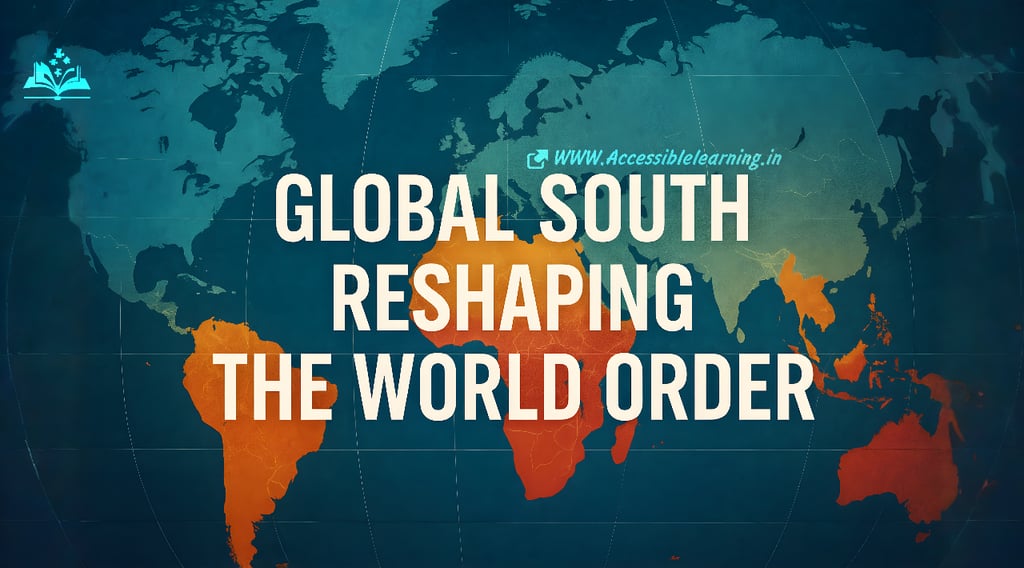
Global South Reshaping the World Order: A Rising Power Bloc Redefines the Future
The Global South is no longer a passive player. Explore how emerging powers from Asia, Africa, and Latin America are reshaping global governance, trade, technology, and diplomacy—challenging traditional Western dominance and building a new world order.
NEWS/CURRENT AFFAIRSPOLITICAL JOURNEYEUROPEAN POLITICS
Kim Shin
7/18/20253 min read


In the 21st century, the balance of global power is undergoing a profound shift. For decades, the world order was shaped by Western powers—primarily the U.S., Europe, and their allies. But today, nations of the Global South—a collective term for Latin America, Africa, Asia, and Oceania's developing economies—are stepping into leadership roles across diplomacy, economics, technology, and climate governance.
This transformation is not sudden. It's the result of decades of marginalization, growing self-reliance, strategic partnerships, and dissatisfaction with unequal global systems. From BRICS expansion to South-South cooperation, the Global South is not just rising—it’s reshaping how the world functions.
Who Are the Global South?
The Global South is a geopolitical concept rather than a strict geographic label. It refers to countries with shared experiences of colonization, underdevelopment, and marginalization from global institutions. Key members include
BRICS nations (Brazil, Russia, India, China, South Africa)
ASEAN members
African Union countries
Latin American powers like Mexico, Argentina, and Chile
These countries account for
85% of the world’s population
More than 50% of global GDP (in PPP terms)
A rising share of foreign investment, innovation, and diplomatic influence
Why Is the Global South Reshaping the World Order?
Dissatisfaction with the Western-Dominated System
Global institutions like the IMF, World Bank, and UN Security Council are often seen as serving Western interests.
Many Southern countries are excluded from decision-making processes.
The war in Ukraine and selective Western sanctions have heightened mistrust.
Economic Growth & Demographic Power
Asia and Africa are home to the world’s fastest-growing economies and populations.
By 2050, India, Indonesia, Nigeria, and Brazil will rank among the world’s top economies.
Urbanization, tech innovation, and rising middle classes are transforming local economies into global players.
Strategic South-South Cooperation
Organizations like BRICS, BIMSTEC, AU, and CELAC promote regional collaboration.
The BRICS expansion now includes countries like Egypt, Ethiopia, Saudi Arabia, and Iran—creating a counterweight to the G7.
Multilateral platforms like the New Development Bank (NDB) provide alternatives to IMF loans.
Digital Sovereignty & Tech Independence
Countries like India and China are creating their own semiconductor ecosystems, digital currencies, and AI research ecosystems.
Latin America is developing its own data protection frameworks.
African nations are building pan-African digital infrastructure for trade and finance.
Rewriting Global Institutions
The Global South is not just demanding reforms—it’s building alternatives.
BRICS+ & Multipolar Diplomacy
BRICS is evolving into a geopolitical force, advocating for de-dollarization, fairer trade, and inclusive governance.
The bloc now represents more than 40% of global oil production and controls critical mineral resources.
Belt & Road Initiative (BRI)
China’s BRI redefines development financing with roads, ports, and energy corridors in 150+ countries.
This challenges the traditional Western aid model, offering infrastructure in exchange for influence.
Global South in UN & Climate Negotiations
Demands for UN Security Council reform include permanent representation for Africa and Latin America.
In climate talks (COP summits), Global South nations are leading calls for climate justice, loss and damage funds, and technology transfers.

The Emerging Norms of a New Order
From Unipolar to Multipolar
U.S.-led unipolarity is eroding.
A multipolar world—where China, India, Brazil, and others act as regional poles—is emerging.
This new structure fosters balance, diversity, and regional autonomy.
Values & Developmental Priorities
Global South countries prioritize non-intervention, respect for sovereignty, and inclusive development.
There's a stronger focus on poverty alleviation, infrastructure, and education over ideological expansion.
Sustainability & South-Led Solutions
Green energy transitions are being led by countries like Morocco, Chile, and India.
South-led innovations include:
Solar irrigation in Africa
Affordable EVs from China and India
Sustainable agriculture in Latin America
Challenges That Still Exist
Despite the momentum, the Global South faces systemic and internal challenges:
Debt burdens and dependence on commodity exports
Internal governance issues, including corruption and weak institutions
Limited coordination between countries despite shared goals
Geopolitical pressures from U.S., China, Russia, and European Union
However, digital technology, youth activism, and South-South trade are enabling unprecedented grassroots and cross-border collaboration.
What’s Next? The Future of Global Leadership
2025–2035 will be a critical decade. The Global South is likely to:
Push harder for reform of global governance
Deepen regional financial systems
Leverage AI, clean tech, and quantum computing for strategic independence
Set the tone for global ethics, digital rights, and climate policies
The Global South is not just a reactionary bloc—it’s an engine of innovation, resilience, and realignment. Its rise is leading to a world less dominated by any single power and more reflective of shared humanity. As the 21st century progresses, it’s not about replacing the West but reshaping global governance to include more voices, fairer systems, and diverse values.
Subscribe to our newsletter
All © Copyright reserved by Accessible-Learning
| Terms & Conditions
Knowledge is power. Learn with Us. 📚


